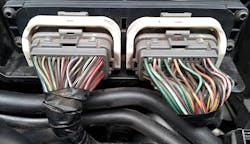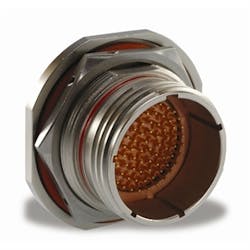Design Connectors to Meet Emerging Automotive Trends
Manufacturers are continuously developing new connector designs and technologies to keep pace with automotive demands. As a result, they offer a variety of off-the-shelf and custom connector solutions to meet application requirements.
Recent changes in consumer trends have steered automotive manufacturers away from producing large SUVs and toward smaller, more compact, more fuel-efficient vehicles powered by electric or hybrid engines.
With this shift in consumer culture, manufacturers are facing new challenges to meet fuel-efficient vehicle specifications, including reduced size, weight, and component count, combined with increased performance, functionality, and ruggedness.
Miniaturization: Size And Weight
While circular connectors suit harsh environment applications, such as industrial and off-road vehicles, new automotive designs are calling for connectors to meet limited space requirements such as narrow power-train compartments. Similarly, sensors for engine, transmission, and suspension systems are space-constrained to employ traditional-sized connectors.
Not only must circular connectors be miniature, then, they also require sealing to IP69K specifications and the ability to withstand the intense shock and vibration conditions common to these environments.
Manufacturers have expanded their circular connector product range to include miniature, 22-mm diameter plug devices with pin counts ranging from two to seven contacts, meeting the needs of these specialized automotive applications. These connectors are highly reliable, direct in-line, multi-pin solutions.
Because they specifically target the harsh environments found in commercial vehicle and industrial applications, the bayonet coupling connectors feature complete sealing to IP67 and IP69K specs to resist engine, transmission, fuel, motor oil, gear-box oil, and brake fluids.
For increased versatility, miniature circular connectors are available with various housings, including plug, flange receptacle, sensor receptacle, splitter (CAN J1939), and wire-to-wire. All versions are designed to meet ISO15170 (formerly DIN 72585) and ISO16750 standards for transmission and engine applications.
In addition to offering high reliability and ruggedness, circular connectors are easy to assemble and disassemble. Many circular connector designs offer a secondary locking mechanism for increased security and typically require no special contact removal tools to unlock the secondary contact insert, resulting in a user-friendly device. With no tools other than a screwdriver necessary to unlock the contact insert in the field, users have a simpler means of correcting any problems that may arise.
Miniature circular connectors may also feature audible and visual indication when mating and locking, along with up to four different mechanical/key and color codings to avoid mis-mating. Easy assembly during mating and harnessing provides further simplification for the end user.
Reducing Component Count
To reduce costs and minimize designs, manufacturers have sought components that increase functionality and reduce component count on the printed-circuit board (PCB).
Advanced interconnect devices have emerged to protect electronic systems from electromagnetic compatibility (EMC), electromagnetic interference (EMI), and electromagnetic pulses (EMPs). To protect electronic systems, it is paramount to maintain the integrity of electronic signals and thus ensure the overall performance of the device.
Traditional methods of EMI and EMP protection include mounting additional devices to the circuit board. Yet such solutions can be costly and less effective, and they often do not conform to increasing real estate constraints.
Alternatively, developments have been made in EMI and EMP protection through mounting chip capacitors and transient voltage suppressor (TVS) devices to flex circuits within a connector, as opposed to the circuit board, providing protection against lightning-induced transients, voltage surges, electromagnetic interference, and ESD pulses, all while conforming to the cost and size limitations of automotive applications.
Manufacturers must protect against both radiated and induced threats to signal integrity. The interconnect serves as the gatekeeper into costly electronics systems that are highly sensitive to voltage-induced transients. Protection is most effective at the interface to the system, placed within the connector.
In most of today’s applications, protection includes capacitive filtering following the protection device to maximize the surge protection to the system. Historically, interconnect manufacturers have been providing solutions within the connectors that have been effective but costly.
Traditional EMI/EMP Protection
Designers traditionally have protected their electronic systems from voltage surges, EMP, and EMI by using one of two methodologies, both of which involve attaching a transorb to every contact in the interface connector.
The first method involves physically attaching a device to the side of each contact within the connector and grounding it to the connector shell. This solution incorporates processes that solder the device and then over-mold it to isolate and insulate the poles of the device from each other.
Surge and leakage current testing of the contact assembly is mandatory, since the processing significantly affects the performance of the system. The small physical size of the device required to use this method minimizes its power dissipation capabilities and results in a longer connector due to transient voltage surge suppression (TVSS) and filtering components.
The second approach requires attaching a pre-tested JANTX-certified (Joint Army-Navy Technical Exchange) device with leads to the contact via circuit boards or other similar techniques, with the other end connecting to the shell.
This method offers the ability to use off-the-shelf devices with a wide range of power-handling capabilities. However, the larger physical size of the leaded devices necessitates larger connector size, usually both in length and diameter.
Alternative Protection Methods
Both of these methods are labor-intensive and costly. To provide a more cost-effective solution, connector manufacturers developed new methodologies for shielding and filtering inside the connectors themselves.
As an alternative, state-of-the-art flexible circuits where individual chip capacitors are surface-mounted on a pad adjacent to the feed-through contact are replacing fragile ceramic planar array block capacitors. Since the feed-through contacts are not soldered directly to the capacitor, stress points impacted by thermal shock and vibration are virtually eliminated.
The resulting design is a robust filter connector with superior mechanical performance and better reliability. These advanced connectors provide standard filtering capabilities, including individual isolated pin filtering of high-frequency noise, built-in ground plane barriers in the connector inserts, and filtering at the face of system boxes.
One example, ITT Interconnects’ Chip-on-Flex (CoF) technology, employs off-the-shelf chip capacitors based on the connector’s dielectric withstanding voltage rating (see the figure). The chip capacitors are mounted on flex circuits to provide the necessary filtering. TVS protection can be accomplished utilizing the CoF technology by simply surface-mounting devices on one of the flex layers or adding a separate layer with Zener diodes or metal oxide varistors (MOVs).
Employing a filter connector design with chip capacitors mounted on the flex circuit provides a number of benefits compared to traditional surge, EMI, and EMP methods of protecting the overall system. Specifically, far less PCB space is required, conforming to tighter space constraints.
Additionally, the filter connector has a ground plane so it provides further protection by acting as a form of shielding. At the system or box level, if a ground plane isn’t present, there is an open signal pathway and an opportunity for EMI. Overall, the system is much more robust than alternative electromagnetic solutions.
Utilizing off-the-shelf devices for both filtering and surge protection also allows connector manufacturers to employ automated manufacturing processes, resulting in a highly cost-effective, compact, and lightweight design while still providing robust, high-performance filter connectors required by commercial and military avionics applications.
Furthermore, the CoF filter approach offers the system designer complete flexibility in defining or changing individual circuit capacitance, ground, and electromagnetic pulse performance during the design and development phase.
In terms of shielding effectiveness, mounting the miniature flex circuits within the connector allows the implementation of multiple circuits at the point of entry within the box. Also, the integral ground plane within the connector can minimize the need for cable shielding, reducing both cost and weight.
Increasing Performance
Consumer enthusiasm for alternative vehicle technologies, including the development of electric vehicles, has rapidly increased in recent years due to environmental concerns and the rising cost of oil. The delay of electric vehicle mass production is undoubtedly due to the lack of a charging infrastructure to support the vehicles.
One recent interconnect innovation has enabled engineers to address the electric vehicle’s charging time requirements, helping to perpetuate the mass acceptance of environmentally friendly vehicles. Previously, the standard charging time of an electric vehicle’s lithium-ion battery was eight hours for a full charge.
With the release of the SAE Electric Vehicle J1772 charging specification in January 2010, a standard adopted in both the U.S. and Japan for Level 1 and Level 2 electric vehicle charging, the automotive market demanded a robust coupler capable of passing the stringent UL 2251 certification. In addition, the application requires a high-amperage charging solution that can provide fast, easy, and safe charging of any electric vehicle.
Interconnect manufacturers have addressed the needs for a high-amperage solution and have reduced the Level 2 charge time by 50%. Utilizing standard ITT VEAM CIR series backshells, flange gaskets, and mounting plates, the electric vehicle interconnect charging solution provides an enhanced cable management system that incorporates robust and proven technology with ground pin contacts on the inlet side to provide a maximum charge in four hours or less.
The charging interconnect system features a single inlet design that allows for Level 1 and Level 2 charging. This advanced charging solution also features high-efficiency power contact technology to provide flexible functionality, with minimal modifications, across a power curve ranging from a low of 15 A/120 V to a high of 75 A/240 V.
The J1772 inlet comes with five contacts: two power, one ground, and two signal. The power and ground contacts are touchproof, and the standard inlet can handle up to 75 A. The flexible interconnect system is proven to meet or exceed both electrical and mechanical UL specifications as well as SAE 1772 specifications across each power curve.
All plastic-based materials carry an F1 rating per UL 746 C and are resistant to engine oils and UV rays. The IP44-sealed charging solution is rated for more than 10,000 cycles.
Conclusion
Connectors meeting fuel-efficient vehicle requirements come off the assembly line with size, weight, ruggedness, functionality, and performance in mind. Innovative solutions must enhance at least one of these characteristics to be considered for automotive designs.
This article updated on 8/17/23, originally posted 5/16/21.

